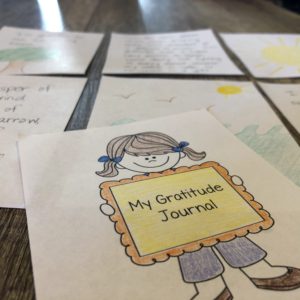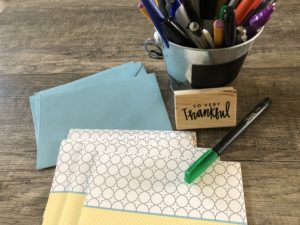A quick picture snapped. A brief, silent prayer. A joyful reflection on the day as we drift off to sleep. Each of these simple elements has contributed to bringing more happiness, light, and peace into my days, as I make a choice to express gratitude for the small things that make up the wonderful life I get to live.
Research indicates that regular expressions of gratitude can play a positive role in our health and well-being. In addition to fostering a positive outlook, a daily gratitude practice can help us build relationships, improve mental health, and even boost physical health.
If you want to turn your life around, try thankfulness. It will change your life mightily. – Gerald Good
Our classrooms are filled with children who are likely experiencing a significant amount of stress and anxiety, and we are working hard to create days filled with joy, wonder, and discovery. One way we can support our students is to help them create a daily gratitude practice of their own.
Thanksgiving is on the way, and teaching students about gratitude is a great alternative to the Pilgrim and Indian lessons we seek to correct, especially for those of us who love the idea of being grateful for what we have but seek to re-frame the holiday entirely.
Here are a few ways to incorporate gratitude into your classroom at Thanksgiving and beyond.

Daily Gratitude
The easiest way to implement daily gratitude with your students is to have a share circle at the end of the day. Gather as a full group in a circle (we do this complete with coats and backpacks). Go around the circle and have each person share something they’re grateful for.
You could also create a small journal for each of your students and have them write (or draw) what they’re grateful for at the end of the day. As part of your morning meeting, a few students could share what they wrote the day before, which would help set the tone for the day.
If you are a one-to-one school or have access to a good amount of technology, there are a number of digital resources that would work well for daily gratitude. Students could create a presentation in Google Classroom and upload an image from the day or write about it. You could do a collaborative gratitude board for your classroom using Padlet (Trello would also work, as would a word cloud generator).
Write Weekly or Monthly Letters of Thanks
In younger grades, this could be a center that’s always open. I would include a ring with the names of people your students want to thank, along with special paper, blank cards, envelopes, and a variety of writing tools.
In upper grades, this could be something you do every Friday. In my class, we do Weekend Journal on Fridays, so we might do Thankful Thursday letters instead. (An important note: I do these in addition to Writing Workshop, when students are allowed to write something of their choice, typically related to our unit of study. I sometimes borrow time from Writing Workshop when the schedule is tight, but I try not to replace their free choice time. If I didn’t have the flexibility to do this, I wouldn’t do both Weekend Journal and letters of thanks during the same week.)

Model
Students echo so much of what they observe from the adults around them. When we cultivate an attitude of gratitude, thanking others and expressing our gratitude for even simple things, we can help students do the same.
Have a Gratitude Circle
I’ve participated in a similar activity as an adult, so this could easily be part of a class meeting or a team/staff meeting. One thing that makes it run smoothly is to clearly set the expectations ahead of time. We sit in a circle and give a word of appreciation for the person sitting to our right. The person to the right listens and says thank you.
One thing I’ve noticed as both a participant and an observer is that hearing the feedback is more challenging for some folks than giving it. It’s important that we are able to receive the complements, appreciation, and love being shared with us by others. This is a skill that some of us (read: me!) had to be explicitly taught. For others, it may come more naturally.
With students, it is important to teach the difference between genuine appreciation and surface compliments. After all, there is a big difference between saying, “I like your new haircut” and “I am so grateful for the way you always help us see the strengths in our writing pieces. Sometimes, it’s hard to try a new skill, and I always feel better when you notice that I’ve tried it.”
Teach Ways to Show Gratitude
Co-create an anchor chart that you can use as part of your class meetings to help remember ways to express gratitude. Refer to it regularly throughout the year to help inspire you!
References:
Giving thanks can make you happier (n.d). Retrieved from https://www.health.harvard.edu/healthbeat/giving-thanks-can-make-you-happier
Morin, Amy. (2014, November 23). 7 Scientifically Proven Benefits Of Gratitude That Motivate You To Give Thanks Year-Round. Retrieved from https://www.forbes.com/sites/amymorin/2014/11/23/7-scientifically-proven-benefits-of-gratitude-that-will-motivate-you-to-give-thanks-year-round/#4165e9cc183c
Flannery, Mary Ellen (2018, March 28). The Epidemic of Anxiety Among Today’s Students Retrieved from http://neatoday.org/2018/03/28/the-epidemic-of-student-anxiety/



